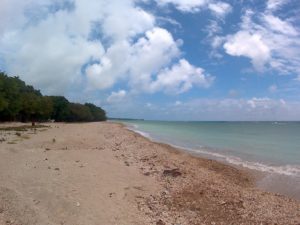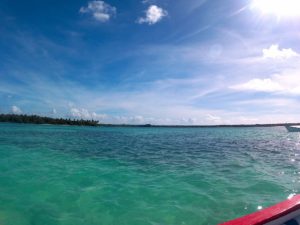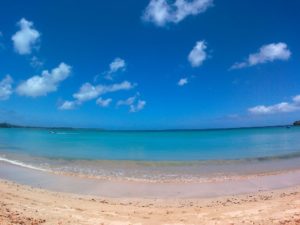Lower Caribbean
The lower Caribbean, the southern tip of Tobago, offers probably the most beautiful beaches and bays for friends of dreamlike sandy beaches. For the most part, the bays are not or hardly developed for tourism. Swimming, snorkeling, other water sports or just relaxing are the most popular activities here. The following list gives a small impression of each section and helps to plan a visit:
Kilgwyn Bay & La Guira

A long sandy beach with shallow, warm water and a transition to “Flying reef”, a popular diving spot. The beach can be reached on foot or by car at the Sandy Point Beach Club. Follow the road parallel to the airport runway until it narrows into a dusty path. From there the beach is within walking distance. The beach is very shallow and therefore suitable for children.
Sandy Point
At the end of the runway at Crown Point airport is this quiet beach lined with palm trees. Some hotels offer the possibility of buying drinks and snacks. The section is quite narrow and somewhat rocky. Due to the strong current, great caution is required when swimming and is partly forbidden.
Store Bay
Probably Tobago’s most famous public beach is the home of many hotels and apartments and usually quite well visited. The annual Great Race Powerboat Race, one of the largest events on the island, takes place on this only 200 metre long section. While lifeguards take care of safety, public toilets, dressing rooms, small shops, restaurants and snack bars offer the amenities of a beautiful beach day.
Excursions to the reef of Buccoo are from there another possibility to spend the day. In contrast to most beaches, there are a lot of flying merchants doing business here, so you have to reckon with more frequent contact.
Coconut Bay
At the Coco Reef Resort you will find this artificially raised beach. A rock face protects the section from strong waves to prevent abrasion. The beach offers an incredibly beautiful sight, but because of its unnatural origin it divides opinions. A small reef has formed on the rock over time and offers a beautiful opportunity to explore the underwater world in a safe way, e.g. by snorkeling. Access is only possible through the hotel. If you are interested, ask in the reception area whether and under what conditions access is granted
Cable Bay
The peculiar name is due to the fact that most supply lines (telephone, electricity) arrive here from Trinidad. It is located at the lower end of Pigeon Point Road and borders Coconut Bay. This small yellow sandy beach is quite flat and becomes rocky at the end.
Pigeon Point
This peninsula is the most beautiful beach of Tobago and with its small thatched cottage is probably the most popular photo motif of the island. The section was acquired by the Tobago House of Assembly (THA) in 2005 and renamed the Pigeon Point Heritage Club. The coral sand and shallow water provide the perfect base for a wonderful beach day. Catering is possible at small snack bars.
The entrance fee is TT$20 (US$3) per person (children from 6-12 pay half price, Indians under 6 years have free admission).
Bon Accord Lagoon & No Man’s Land

The lagoon of Bon Accord Lagoon is crossed by swampy mangrove forests and therefore home to many bird species. This section can only be reached by boat. The adjoining sandy beach of “No Man’s Land” is a popular destination for a barbecue from boat tour Providers.
Buccoo Bay

In front of this long narrow sandy beach lies the famous reef of Buccoo. At high tide the beach is extremely narrow – so it is advisable to look for a place as high up as possible. At the Fischer-Kooperative there is a small toilet and a bar. Bad is very pleasant due to the shallow and shallow water. As the beach is usually not very crowded, there is a romantic atmosphere, which is occasionally exploited by thieves – so do not leave any valuables on land when you are in the water.
Grange Beach
This section is known to locals as “The Wall” and is located on the golf course of Mount Irvine. The beach is a good place for swimming and is becoming more and more popular with surfers.
Mount Irvine Bay
This approximately 800 metre long section is also known as Little Courland Bay and consists of two parts, one of which is much narrower. The first part is also the beach of Mt Irvine Beach Hotel and perfect for swimming and sunbathing. In the second, northern part there are changing rooms and a toilet. This section is the starting point of many sailing tours and is very popular with surfers from December to March.
Back Bay
This small and secluded beach is one of the most beautiful on the island, but is difficult to reach due to its cliff access. It is therefore advisable not to go there alone. Due to the remote location there are no valuables to take with you or leave on land.
The access is via a small path directly opposite Gleneagles Drive, approx. 400 meters behind the beach building in Mount Irvine Beach Facilities. Keep left at the fork. At the end we take some stone steps to the beach.
Stonehaven Bay
At the Grafton Grafton Beach Resort you will find this coarse sandy beach with high waves and currents – so be careful when swimming. The northern part of the beach is a bit quieter and can be used for snorkeling. The beach of Stonehaven is one of three beaches on the island where from March to June leatherback turtles come ashore to lay their eggs; three months later their offspring hatch.
Turtle Beach
Turtle Beach is a kilometre-long sandy beach and is known as a nesting place for leatherback turtles. At the Turtle Beach Hotel you can buy refreshments. Do not let the people who offer aloe vera treatment, for example, spoil your day – a consistent “no” is usually enough to get you back to rest. Otherwise, simply speak to a security guard at the hotel.
Hotel guests have the advantage that during the “turtle season” they can take advantage of the Turtle Watching offered by the hotel. Observers inform immediately if a turtle is seen laying eggs or a small one leaving the nest. Some tour operators also offer qualified trips to this beach. More information can be found on the Internet at www.sos-tobago.org.
Plymouth
North of Plymouth there are three bays with two beaches, which are usually deserted and mainly used by the inhabitants of the city. Access is only possible from the old road to Arnos Vale. Do not confuse the bay also called “Back Bay” with the bay of the same name between Mt Irvine Bay and Stonehaven Bay.
Arnos Vale
This rather small beach is located at the former Arnos Vale Hotel. Access is possible via a small path to the left of the hotel entrance. The conditions for swimming are very good, for snorkeling this is one of the best places on the island. Due to the remote location, we only recommend visits in groups and without valuables – in the past there have unfortunately been occasional attacks.
The Mot Mot Trail is a dirt track and the original coastal road between Arnos Vale and Culloden. From this great path there are several ways to reach lonely small bays and beaches.


